History
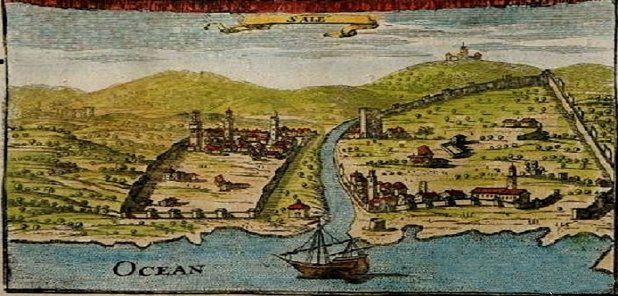
Salé is one of oldest cities in the Islamic Maghreb, it was founded around the beginning of the 11th century by Banu Achara dynasty which was under the sovereignty of Banu Ifran. It is well known that this dynasty had made of the region of Shellah a staging ground for it in fighting the Berghouata Emirate, which deviated from Islam, without achieving its total eradication. It seems that the city controlled the territory of Shellah and a part of its population after expelling the Berghouatans and pushed them towards the south-east region.
Given the power and wealth of this clan as well as its care for science and literature, their palace court attracted writers, ordinary people from the surrounding areas and even from Andalus. This preliminary effort led to the establishment of a residential area known as Blida. In a short period of time, another wave of migrants came from Zenata region and Andalus which remarkably contributed to expanding the core territory of the Emirate. Banu Ifran built the Zenata neighbourhood in the north-east side of the city. Later the Andalusian clan of Bani Khayroun, newly settled in the city, built the new neighbourhood,called after them, which is of Khyar Alley.
Al-moravids dynasty invaded the region in 1073, they eradicated both the Emirates of Berghouata and Banu Ifran, however they allowed Banu Achara to keep their previous privileges and they granted the member of this clan, exclusively, the judiciary function. During their reign,the Moravids built the Shahbae Mosque where the Friday preaching was given. Almoravids contributed in fortifying the defences of the city enclosing it with a wall made of stones and gates especially the ones which open to the routes to Fes and Ceuta.
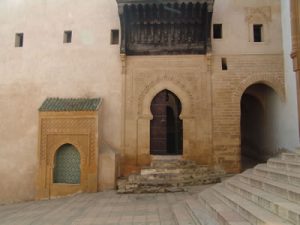
When Almohads came to Bouregreg river mouth in 1132, The kalifate Abdelmoumen ordered the destruction of the wall south of the city to make its control easier. And during his reign Salé joined the revolution led by Ibn Hud Al-Mezi, but he succeeded in regaining power over the rebelling regions and Salé enjoyed a great prestige during his reign.
During the reign of Yakub Al-Mansur, the third Kalifate of Al-Mohads dynasty, Salé received a special interest from him. The great Mosque, the biggest in Morocco then, was built in 1196 and an interior part of it was devoted to teaching Quran and Hadith. The outstanding Mosque of Dawud with its peculiar unfinished minaret in Bu Rmada neighbourhood dates back to that period of time. The following year saw the construction of a new neighbourhood under the name of Talaà connected to the bank of Rabat with a ten-meter wide bridge.
Salé had played a significant role in Al-Mohads history. With Rabat, it was where the Kalifates of this dynasty settled for months and prepared their campaigns towards other regions in Mghreb and Andalusia. Both cities profited from these stays in terms of efforts made in urbanization. This crucial role had also made Salé a target of many rebel groups. One of them is Ibn Waqarit, an Al-Mohads Sheikh, who joined Ibn Hud who led rebellion in Andalusia.
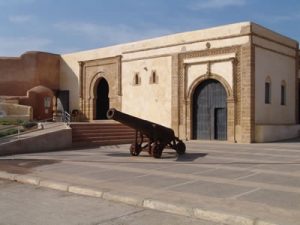
The entry of the Marinid Sultan into Salé was the beginning of a special relation between the city and the members of the reigning family thanks to the monumental accomplishments realised by them which still survive and remind of the many and varied manifestation of civilisation that prevailed in Salé. The Marinid made of it a centre of one of the nine Moroccan provinces, built its Southern wall and made the Shipyard at the south-east corner an extension of it. They also established the Talaà School, the Ajiba School and a Zawiya (monastry) for hermits, in addition to two small mosques. Another unique monument built by them was the arcades wall with a water canal on top of it to bring water from the Maamora marsh.
The situation of the Marinid dynasty had not only positive aspects but also negative ones. Their defeat against the Christian fleet in 1341 marked the beginning of the decline in the city activity related to the flourishing Jihad passion in Andalusia, and lurched gradually backwards in importance. This could be seen in tales found in historical references: unlike in the previous eras the Sultans stopped to settle there for long periods, urbanisation stagnated since the death of Sultlan Abu Inan. Worse than that, their presence in the city was driven only by fighting on the reign. Like the rest of the country, Salé had been suffering from a deep crisis under the leadership of Sheikh Abu Zakaria Yahya Al-Wattasi who swore allegiance to the Emir Abdulhaq, the last Sultan of the Marinid dynasty.
In spite of the return of political stability in Morocco, after the Assaadi dynasty took power, their reign remains to be a vague period in the history of Salé because of the scarcity of references, except for sporadic hints to their care for ship building in the Shipyard, the restoration of the Bab Mrissa Arcade by the king Abdel Malik Assaadi and some general briefings on the situation of Salé during the reign of Assaadi dynasty. As Assaadi state entered in a period of disruption with multiple fightings between the emirs, who had bad reputation, on the reign it was noted that Salé was practically under the reign of the kingdom of Marrakesh and managed by a representative of Assaadi authority from Al Mohads Kassabah at the southern bank. It is also noted that the city suffered from various manifestations of the country s political aspect especially after the death of the Sultan Al Mansur. Under these circumstances the role of the Suffi leaders surfaced again. The Sheikh Hassoun moved to Salé and settled in it and had important effect on the stakeholders in the city and subsequently extended to other neighboring regions. The mujahid Mohamed Layachi Maliki, who came from an ancient decent family, was one of his student. He withdrawed towards Sale in 1615 and stayed there until he got the allegiance, obedience and support of its inhabitants. However his relations with the Andalusians passed through difficult periods ended by fighting them with the assistance of the British.
The fightings started in 1631, and it seems that the battles against the Andalusians had not achieved the expected results, this explained by the long duration of the war (for many years) where alliances changed sometimes. The Andalusians, for their part were not sitting idle: They initiated attacks to control Kassabah and expulsed its population towards Salé. Which led to the besiegement of Rabat again by the forces of Layachi who ultimately was assassinated by the Khalt tribe who were accomplices of Dellaís and the Andalusians.
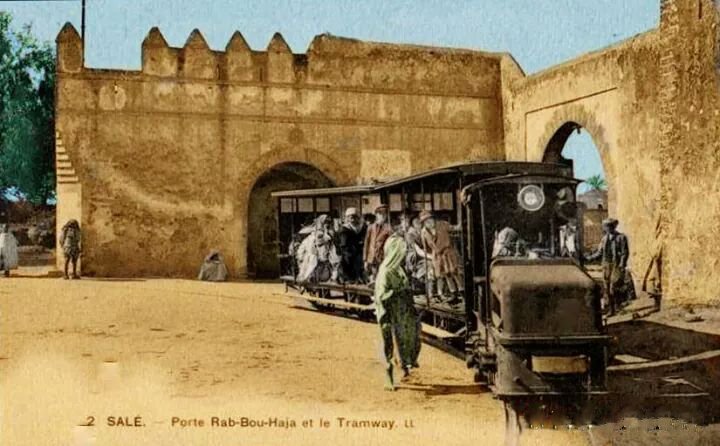
The Dellais seized the opportunity of the end of Layachi to extend their influence on the mouth of Ab u Regreg river. Muhammad al-Hajj ad-Dila’i, appointed his son Abdullah as Emir of the cities situated at the mouth of the river, he made of Kassbah his headquarters. In view of the importance of the naval activity in the life of this city, the mission of the Emir consisted mainly in managing the foreign relations with the European powers who cared at the first place for the safety of their citizens and liberating their captives. Starting from 1664 the majority of the population along the two banks of the river accepted to join the Ghaylan Brigade, Ghaylan was one of Layachi commanders, but this situation did not last long, because the Alawit would soon take control over the region and unified the country. The Sultan Moulay Rachid entered the city of Sale in 1670.
It seems that the attention of the State was focused then on building defences to protect the city of Salé, and later on the sultan of Mulay Ismael built the Gnawa Kassbah and the Sidi Mussa Dome and restored the arcades. The death of this Sultan marked the beginning of a deep political crisis which led to the stop of the major construction projects which began during his time.
As a result, the city became independent under the leadership of the Lieutenant Abdelhaq Fenech who managed the city affairs until his appointment as its leader by the Sultan Mulay Abdullah. Many big construction projects were carried out during this period such as Sidi Hassan Alaydi Dome at the Swiqa neighbourhood and the construction of Sidi Ahmed Haji mosque and Zawiya in addition to Sidi Ahmed Bin Aachir Dome which was built in 1733. Even at our present time, we can recognize some of those market places, economic facilities such as the big Souk and the office of the market inspector, wind and water mills and some coin-minting workshops of which only one still exists at the Old Mellah next to Hotel Askour. The city grew bigger during this period due to the constructions made by the Lieutenant Abdelhaq Fenich who built, on instruction from the Sultan Mohamed Ibn Abdellah, a big tower overlooking the sea which is still known as Borj Addomoue (Tower of Tears) or Borj Alqaed (Tower of the Leader), he also built another big tower at Bab Sebta and used it as his base.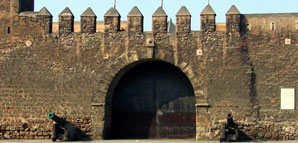
During the 18th and 19th centuries, many constructions were added to the urban landscape such as the Jazarin Mosque and the New Mellah at the site of the house of Industry at the south-east of the city built in 1808 during the reign of Sultan Moulay Sulaiman. His reign period left much impact on the history of Sale due to the treaty signed with some European countries in 1818 on stopping piracy. As a result, the city entered another era on both economic and demographic levels thanks to its privileged position as a crossroad between the north and south of Morocco.
One of the key milestones in the history of Salé was the death of Sultan Hassan I in 1894 and its results when the population automatically gave allegiance to Sultan Abdelaziz, which opened the way for local rivalries on who should be the leader of the city. At the end Mr. Tayeb Sbihi was appointed at that position for he was in good terms with Sultan s nearest circles. However this was jeopardised by a new crisis which resulted from the destitution of Sultan Abdelaziz and declaring allegiance to Sultan Abdel Hafid. The population of Sale were taken by surprise and as soon as they heard that the Sultan delegation is leaving the city towards the two river banks they declared their support to him and invited him to visit the city. And indeed, the Sultan had entred the city and visited its shrines before heading for Rabat where he settled for 10 months. As the population of Sale saw that Sultan’s troops defeated by the Rhamna tribes, they gave their allegiance to the Sultan Abdelhafid in the summer of 1908.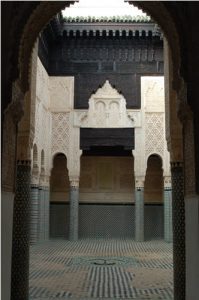
The date of 27th April 1911, marked the first entrance of the French troops to Sale on their way towards Fes. They occupied the gates and the towers at the southern area, and destroyed the ones overlooking the sea and burned its canons before withdrawing to outside the fences.
During the 19th century, the city of Sale saw some additional urbanisation, the defences at the old Seqala near Sidi Bin Acher shrine were completed in 1885, during the reign of Sultan Hassan I. The lieutenant Mohamed bin Said built around 1977 another fence along the wall towards the river to protect the unsafe sand area as well as the old Musallah. And he opened a gate with the name of “ the gate of the wind“ which was closed during the night. As the city grew bigger in the recent years, the Mussalah was transferred to another place near the cemetery of Bab Lmel’aqa in front of Abi Abdellah Almejrad shrine.
What featured perhaps the city then is perhaps the increased number of the new neighbourhoods because of the mass migration from other nearby tribes who settled in uninhabited places such as Bab Chafaa, Bab Sebta, Swiqa and Saff. By the next century, there was already 15 neighbourhoods in the city with sixty mosques but the Friday preach could be delivered only in three of them which are the Great Mosque, Chahbaa and Sidi Ahmed Haji.
Although the number of neighbourhoods had increased, by early nineteenth century, but most of it consisted only of groves and yards, the number of which reached fort y-two, and was owned by some Slawi families who lived on it usually through direct exploitation.
The beginning of the protectorate era marked the break from the traditional urban system in Salé. As soon as the French took control over the country, they started implementing their views regarding its modernization. They did that with the assistance of the city dignitaries. The first measure they undertook was the establishment of a municipal council in 1913 consisting of four Muslim members, Christians and Jews.
The fist accomplishment of this new institution was the development of infrastructures such as paving the road leading to Rabat and the one beside the military barrack. An unpaved road network built around the city, other roads inside it remained unpaved but were rehabilitated and side-pavements were added. The water canal was also repaired so that water could be transported on top of the arcade wall and be harvested in a basin in Bab Chafaa provided with a hundred of public lighting gas-lamps. In addition, two hospitals were built: one for men and the other one for women. A school for the children of town dignitaries was built in the Bab Hssain neighbourhood in the 1rst of November 1912.
Reference: the book titled “Aspects of the History and Urbanization of Salé from foundation until the beginning of the 20th century“ Mohamed Fatha –2012- the future of salé association.
